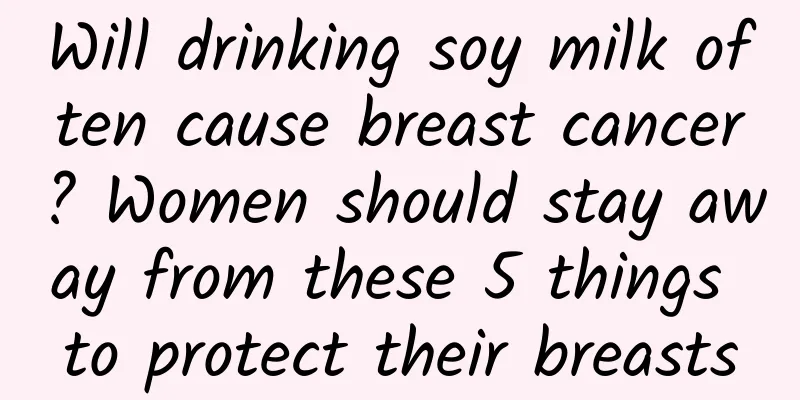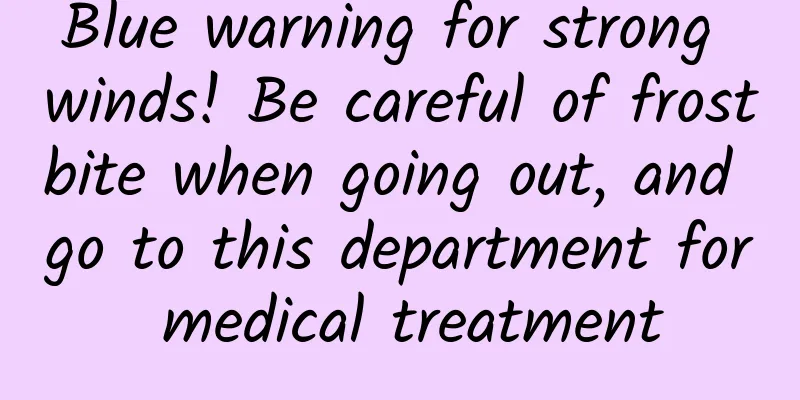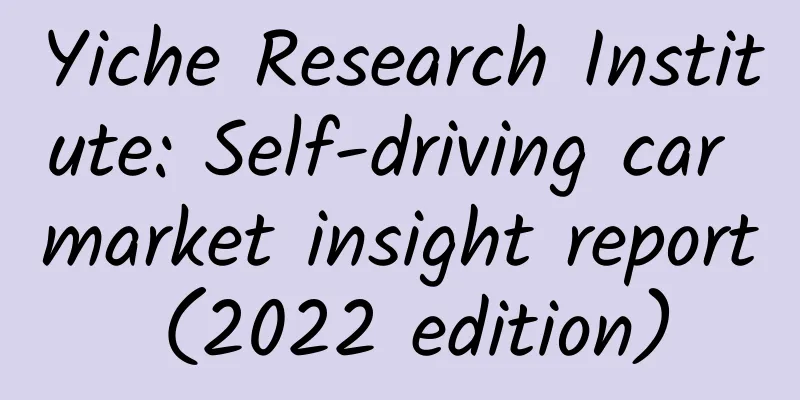Will drinking soy milk often cause breast cancer? Women should stay away from these 5 things to protect their breasts

|
"Drinking soy milk can cause breast hyperplasia" Some time ago, the topic #Is breast hyperplasia really caused by soy milk# became a hot search on Weibo, sparking heated discussions among netizens. Rumor Analysis The rumor that "drinking soy milk is bad for the breast and can induce breast hyperplasia and breast cancer" has been circulating for many years. Now, after numerous studies, soy milk can no longer be blamed. Breast health has nothing to do with drinking soy milk. Drinking soy milk and eating soy products regularly will not induce breast diseases, but can protect breast health and prevent related diseases. Will drinking soy milk regularly cause breast cancer? The reason for this rumor is that soy milk contains soy isoflavones, which many people regard as estrogen. In fact, soy isoflavones are not equivalent to real estrogen . Soy isoflavones are secondary metabolites formed during the growth of soybeans and other leguminous plants, also known as phytoestrogens. They are one of the biologically active ingredients in soy products and can bind to estrogen receptors in different tissues and organs of the human body to play the role of estrogen or antagonize endogenous estrogen. For example, when the estrogen level in the human body is reduced, soy isoflavones can help increase estrogen; when the estrogen level in the body is increased, it can play a role in lowering the estrogen level. In general, soy isoflavones are a player that can help us maintain a balance of estrogen levels in our body. Regular consumption of foods containing soy isoflavones (soy milk, tofu, dried tofu, yuba, etc.) can help improve cardiovascular health, prevent osteoporosis, and protect breast health. Copyrighted stock images, no reproduction is authorized Studies have shown that the intake of soy and its products can reduce the risk of breast cancer in premenopausal women and in postmenopausal Asian women. Meta-analysis data show that daily intake of 26.3 mg of soy isoflavones (equivalent to 15-50 g of soy) can reduce the risk of breast cancer. Researchers at home and abroad have conducted many studies on soy isoflavones and found that they can inhibit cancer cell proliferation, induce cancer cell apoptosis, resist oxidation, inhibit the formation of new blood vessels, and reduce the risk of breast cancer, prostate cancer and other cancers. Another study included 70,578 Chinese women aged between 40 and 70. The study found that adult soy intake was negatively correlated with breast cancer risk. For premenopausal women, those with the highest soy isoflavone intake (55 mg per day) had a 46% lower risk of breast cancer than those with the lowest intake (11.1 mg per day). Copyrighted stock images, no reproduction is authorized The results of epidemiological and clinical studies support the potential protective role of soybean and its products in preventing breast cancer. The "Chinese Lifestyle Guidelines for Breast Cancer Patients" also mentioned that soy isoflavones have the effect of preventing breast cancer and can reduce the risk of recurrence in breast cancer patients . It is recommended that breast cancer patients take soy products as part of a healthy diet, but should be vigilant about related dietary supplements. Therefore, whether it is breast hyperplasia or breast cancer, it is not caused by drinking soy milk. Soy milk is not to blame! What may actually cause breast cancer These are the 5 things Breast cancer is the malignant tumor with the highest morbidity and mortality rate among Chinese women, and it seriously threatens the health of Chinese women. In addition to genetic factors, there are many bad habits in life that are the "culprits" that induce breast cancer, and they must be changed as much as possible. So what habits are likely to induce breast cancer? 1 Smoking Smoking is not only a risk factor for lung cancer, but also has a certain promoting effect on the occurrence of breast cancer . A 2017 epidemiological survey involving 28 EU countries showed that compared with non-smokers and those not exposed to secondhand smoke, the 10-year risk of breast cancer among smokers and those exposed to secondhand smoke increased by 10% and 7%, respectively. People who have the habit of smoking must quit smoking for the health of themselves and their families. 2 Drinking Drinking alcohol also increases the risk of breast cancer . In terms of alcohol consumption, every 10g/day increase in alcohol intake will lead to a 10.5% increase in the overall risk of breast cancer. Another prospective study with a median follow-up time of 10 years found that compared with non-drinking women, women who consumed ≥30g of alcohol per day had a 32% increased risk of breast cancer and a 43% increased risk of invasive breast cancer. Copyrighted stock images, no reproduction is authorized 3 obesity Currently, obesity is a global issue that has attracted much attention. Failure to control weight and resulting in overweight and obesity is a major threat to health and is also one of the factors that induce breast cancer . There is evidence that obesity and overweight in adulthood increase the risk of breast cancer after menopause. A study on Chinese people showed that women with a BMI of more than 28 kg/m2 (mainly increased subcutaneous fat) are more likely to develop hormone receptor-positive breast cancer, while women with a waist-to-hip ratio of more than 0.85 (mainly increased visceral fat) are more likely to develop hormone receptor-negative breast cancer. Even for people with normal BMI, a high body fat percentage will increase the risk of breast cancer, and for every 5kg increase in fat, the incidence of estrogen receptor-positive breast cancer increases by 56%. In addition, a meta-analysis showed that obese women with breast cancer have an approximately 30% increased risk of recurrence or death compared with women of normal weight. 4 Not into sports Lack of exercise can lead to weight gain and fat accumulation. Excessive fat can promote the production of estrogen, which in turn increases the risk of breast cancer. Exercising more can improve the body's immunity, reduce body fat percentage, and help prevent breast cancer . Studies have shown that exercise can reduce the survival, proliferation, and invasion of breast cancer cells. There are also reports that exercising between 8 and 10 a.m. has the best effect on preventing breast cancer, which may be related to the rhythm of estrogen secretion, and more clinical data is needed to further prove it. 5 Bad mood, high stress Japanese scholars conducted a prospective study on 15,107 women aged 40 to 64, and found that women with extroverted personalities had a lower risk of breast cancer after 17 years of follow-up. The Netherlands also conducted a large-scale prospective epidemiological survey and found that high stress in life is related to the overall risk of malignant tumors, and is more closely related to the risk of breast cancer. We should try to maintain an optimistic attitude, reduce stress and reduce the incidence of breast cancer. Preventing Breast Cancer It is also recommended to eat them In addition to eating soy products regularly and changing bad habits to help us prevent breast diseases, it is also recommended to eat more of the following foods. 1. Foods rich in n-3 unsaturated fatty acids , such as mackerel, yellow croaker, sea bass, eel, flaxseed oil, perilla seed oil, etc. 2. Cruciferous vegetables , such as radish, broccoli, cabbage, kale, cabbage, purple cabbage, etc. 3. Milk and dairy products . Summarize Protecting breast health is important, but it has nothing to do with drinking soy milk. Drinking soy milk and eating soy products regularly will not induce breast diseases, but can protect breast health and prevent related diseases. In addition, it is recommended that adult female friends in my country have regular physical examinations and breast cancer screening, especially for women over 40 years old. Looking in the mirror of rumors Some rumors are disguised as professional terms, and ordinary people often do not understand these terms, so they are easily deceived by rumors. When you encounter words and knowledge that you do not understand on the Internet, it is recommended that you be more skeptical and confirm the accuracy of the information on reliable popular science platforms. References [1] Chinese Nutrition Society. Dietary Guidelines for Chinese Residents[M]. People's Medical Publishing House. 2022 [2]Baglia, Michelle L et al. “The association of soy food consumption with the risk of subtype of breast cancers defined by hormone receptor and HER2 status.” International journal of cancer vol. 139,4 (2016): 742-8. doi:10.1002/ijc.30117 [3] Chinese Association of Preventive Medicine, “Lifestyle Guidelines for Chinese Breast Cancer Patients”, 2017 [4] Zhang Xiaohui, Sun Qiang, Li Yan, et al. Expert consensus on breast cancer prevention in Chinese women[J]. Chinese Research Hospital, 2022, 9(04): 5-13. DOI: 10.19450/j.cnki.jcrh.2022.04.003. [5] Chinese Anti-Cancer Association Tumor Nutrition Committee, Chinese Medical Association Parenteral and Enteral Nutrition Branch, Li Wei, Shi Hanping. Expert consensus on nutritional treatment of breast cancer patients[J]. Electronic Journal of Tumor Metabolism and Nutrition, 2021, 8(4): 374-379 [6] Continuous Update Project, Diet, Nutrition and Physical Activity and Breast Cancer, 2017, available [7]Kang, Chifei et al. "Diabetes, Obesity, and Breast Cancer." Endocrinology vol. 159,11 (2018): 3801-3812. doi:10.1210/en.2018-00574 [8]Minami, Yuko et al. "Personality and breast cancer risk and survival: the Miyagi cohort study." Breast cancer research and treatment vol. 150,3 (2015): 675-84. doi:10.1007/s10549-015-3364-9 [9]Oerlemans, Marjolein Ej et al. “A meta-analysis on depression and subsequent cancer risk.” Clinical practice and epidemiology in mental health : CP & EMH vol. 3 29. 3 Dec. 2007, doi:10.1186/1745-0179-3-29 Author | Xue Qingxin, registered dietitian Review | Ruan Guangfeng, Deputy Director of Kexin Food and Health Information Exchange Center The cover image and the images in this article are from the copyright library Reprinting may lead to copyright disputes |
<<: The earliest urban planning in modern China turned out to be a little-known
>>: Does drinking coffee relieve headaches or make them worse? Coffee and pain, friends or foes?
Recommend
An explosion at a firecracker factory in Guanghan, Sichuan, has injured six people
CCTV reporters learned from the scene that the fi...
Why would Microsoft launch an Android phone?
For us, the operating system is no longer the mos...
In 2014, Android Wear shipments were only 720,000. Who bought them?
[[127864]] Beijing time, February 12 morning news...
World Bank Report: Fusion of Technological Revolution and Human Capital
South Asia’s human capital challenges are among t...
Do you know these Winter Olympics venues?
Nickname: Ice Ribbon Venue name: National Speed ...
Huawei's light flagship nova targets young and active consumers by achieving its 100 million units target ahead of schedule
As the popularity of smartphones in China receded...
If you see these creatures on the beach, don't touch them!
During the hot summer, many people like to go to ...
Zhong Liti’s daughter cheered for Meng Jia and imitated Meng Jia’s tone! Such a capable sister, everyone likes her
Christy Chung's two beautiful daughters cheer...
Practical knowledge on field marketing gained through spending hundreds of thousands of dollars in practice!
Startup companies have few resources, a shortage ...
Tips for writing promotional plans!
1. What is a promotion plan? Before we know how t...
Free! Batch! No need to connect to the internet! Extract text from images with this app!
Which method do you use to extract text from imag...
What are the things to pay attention to when leasing IDC large bandwidth?
What are the things to pay attention to when leas...
128G mobile phone memory is the most cost-effective! Did you choose the right one?
In recent years, we always see some articles titl...
Analysis of Meituan and Pinduoduo’s e-commerce coupon competitors!
Jingxi’s coupon system was inherited from JD.com,...









